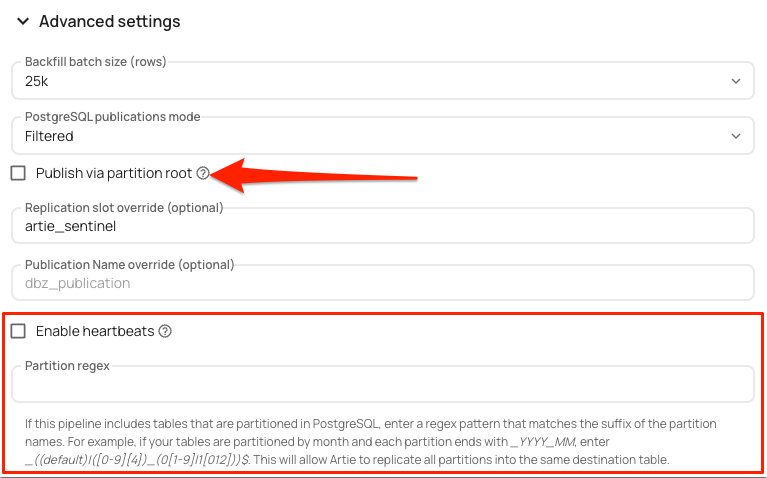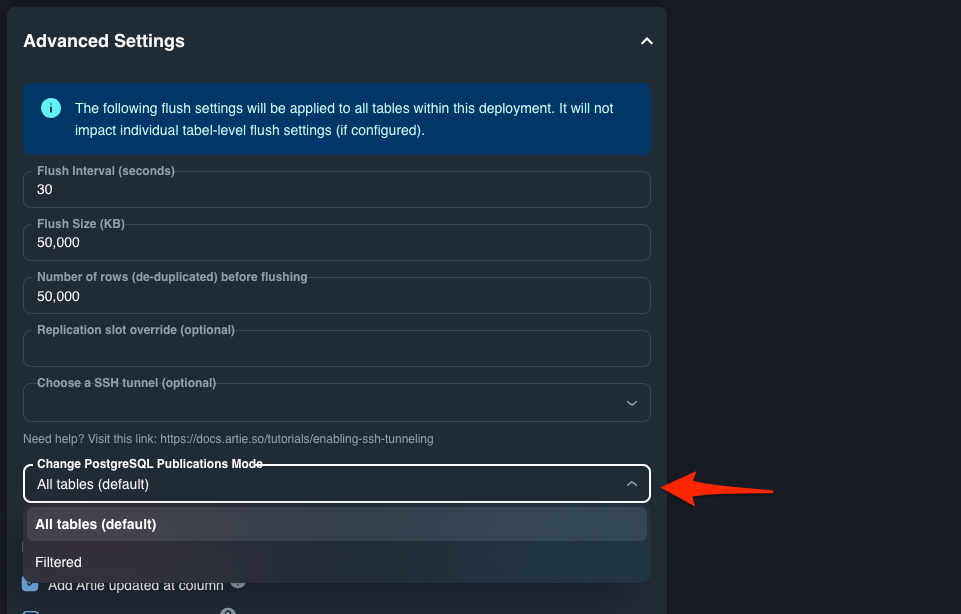Required settings
- Host name
- Port (default is
5432) - Service account
- Database with logical replication enabled
Provider specific instructions
Additional features
Partitioned tables
Partitioned tables
Artie will automatically detect partitioned tables and will automatically fan data into a single table in the destination.
- If you have specified
publish_via_partition_rootto betruein your publication, no additional work is needed. - Else, you will want to open up the pipeline advanced settings and make sure the regular expression matches your partitioned table names. Further, if your partitions are stored in a separate schema, you can specify the child schema name under the table advanced settings.

PostgreSQL 16
PostgreSQL 16
PostgreSQL 16 introduces the ability to use logical replication on a standby server.Steps to enable this:
- Create
dbz_publicationpublication on the primary database
- Enable
hot_standby_feedbackon the standby server
WAL_LEVELis set tologicalon the standby server
Heartbeats
Heartbeats
Once you selected
Enable heartbeats under Advanced settings, you will then need to run the following command:Customize publications mode
Customize publications mode
Don’t want to enable publications to capture all the tables? You can change this behavior by selecting 
Filtered under the Pipeline advanced settings.If you change this to be filtered, you are responsible for adding and removing any captured tables from the publication. Our validation will check that the publications is configured correctly.
Changing the behavior of Postgres publications
TOAST columns
TOAST columns
TOAST (The Oversized-Attribute Storage Technique) is a mechanism used by Postgres to store large column values to alleviate the page size limit. TOAST columns may be different data types such as
text, jsonb, bytea, array, etc.One thing that is special about TOAST columns is that if the column value has not changed, the column value will not be included in WAL if the table’s replica identity is set to default. Artie has automatic detection built-in to detect an unchanged TOAST column and will conditionally replicate this into the target database.Our built-in process will detect if an incoming CDC event has an unchanged TOAST column and will not update the column value in the target database. We are able to do all of this without having to increase your table replica identity.Monitoring
Monitoring
We have regular monitors that provide additional guardrails around your database replication, and will do the following:
- Regularly check and monitor your replication slot size in 15-minute intervals and notify if the slot exceeds a certain threshold.
- Heartbeats verification. For folks that are leveraging heartbeats, we will alert you if a heartbeat query fails.
- Terminate any idle queries that are lingering for more than a day. You can avoid having this problem by setting
idle_in_transaction_session_timeout.
Questions
Should I enable publications for all tables?
Should I enable publications for all tables?
We recommend enabling publications for all tables. This will ensure that you are capturing all the changes to your database and you will not need to manually add and remove tables from the publication.In the case where you only want to capture a small subset of tables in your database, you may want to enable publications for the specified tables. This will require you to manually manage the publication.
Can we connect to an Aurora read-only endpoint?
Can we connect to an Aurora read-only endpoint?
We can connect to the read-only endpoint for backfills. However, we will need to connect to the write endpoint to consume from change data capture.